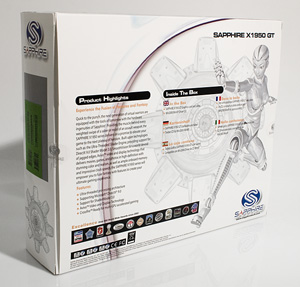Sapphire Radeon X1950 GT 256 MB
Introduction
There is a common occurrence in the graphics industry that happens near the launch of any major new architecture. Before a company introduces a major change in their GPU designs, they will take their existing GPU designs and offer them at a wide variety of different speeds and price points, sometimes surprisingly low priced, in order to clear out inventory before their new architecture comes into view. The most recent example of this would be Nvidia's GeForce 7900 GTO, which launched just a few weeks before their new GeForce 8 architecture, and provided amazing price/performance levels for those who bought it, but was quickly put out of favor when Nvidia's DX10 architecture launched.
We may be seeing a similar scenario with ATI's latest GPU models, which use their existing architectures but are priced quite low in comparison to what we've seen in the past. Of course, ATI is long rumored to be in production of DirectX 10 compliant graphics processors from the top to bottom ends of the market, so seeing "new" GPUs based on existing DirectX 9 architectures, like the card we're looking at today, strikes us as ATI simply getting the most mileage possible from their existing design. This certainly isn't a negative, however. Their existing DirectX 9 designs are stable, have been in production long enough that most if not all of the kinks have been worked out, manufacturing yields are undoubtedly greater than they were at introduction, and they have fully working drivers.
ATI's "newest" graphics processor is dubbed the Radeon X1950 GT, which is based on the same RV570 core that was featured in the Radeon X1950 Pro line. However, the X1950 GT is a more attractive product, as ATI has dropped their price point down to $150 with minimal drops in clock speed in comparison to the $250+ X1950 Pro model, while keeping nearly every major feature identical. We got our hands on the new Sapphire Radeon X1950 GT card, which has been garnering very solid reviews thus far, for a comparison against other cards in this similar price point.

Shipping Box - Front |

Shipping Box - Back |
|
|
|

Stoking the passion within for adventure the Sapphire Radeon X1950 GT brings next generation performance where games are no longer chained to the limited capabilities of PC hardware to the affordable mainstream market! Tomorrow's evolving in-game demands for feature rich environments now find themselves a reality with hardware features such as: the industry acclaimed X1950 GPU, 256MB of onboard memory, and increased performance via CrossFire support. When you couple impressive hardware advancements with next generation software support for Windows Vista 3D environment, DirectX and OpenGL the journey to a graphically enhanced tomorrow is accelerated with the tools of tomorrow made available today by Sapphire and the Sapphire X1950 GT.
|
|
Sapphire clocks the Radeon X1950 GT at levels which are close to, but slightly lower than the Radeon X1950 Pro. While the Radeon X1950 Pro featured the RV570 GPU clocked at 580MHz with 1.4GHz GDDR-3 memory, the Radeon X1950 GT features the RV570 at 500MHz with 1.2GHz GDDR-3 memory. While a 500MHz GPU clock may seem quite high for a mid-range part, keep in mind that this GPU features 36 pixel shaders, which is 3/4 that of the high-end Radeon X1950 XTX's 48 pixel shaders, meaning that this GPU does less work per clock compared to these high-end GPUs. On the plus side, ATI's prior mid-range card, the Radeon X1600 series, only had a 12 pixel shader design, so for the price, the Radeon X1950 GT will be a major step up compared to the last generation.






